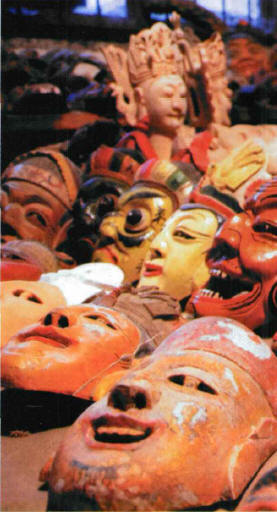User:Mickeyinchina/Nuo Opera: Difference between revisions
| Line 56: | Line 56: | ||
==Masks== |
==Masks== |
||
[[image:Nuo_opera_masks.jpg|frame|left| |
[[image:Nuo_opera_masks.jpg|frame|left|100px|Masks used when performing [[Nuo opera]]]] |
||
==See Also== |
==See Also== |
||
Revision as of 21:38, 12 October 2008
 Caption for example.png | |
| Header defined alone | |
|---|---|
| Data defined alone | |
| All three defined (header) | |
| Label and data defined (label) | Label and data defined (data) |
| Below text | |
Nuo Opera or Nuo Drama (simplified Chinese: 傩戏; traditional Chinese: 儺戲; pinyin: nuo2xi4), deemed as "living fossil of opera", is one of the most popular folk operas in southwestern China and has a long history. Characterized by its special features - such as the ferocious masks, unique dresses and adornments, the strange language used in the performance, and mysterious scenes, nuo opera has been selected as one of China's non-material cultural legacies. The opera integrates religious and dramatic culture. The most unique symbol of nuo opera, the masks, can be considered as a treasure of Chinese folk ark.[1] The masks of nuo opera are also believed to be the origin of the facial painting used in another famous Chinese opera - Beijing opera.
In ancient times, nuo opera was very popular in the Yangtze River, Yellow River and Nenjiang River valleys. However, with the development, the opera's popularity waned in those river valley areas. Nowadays, it still remains popular among the rural areas in southwestern China, such as Guizhou, Anhui, Jiangxi, Hubei, Hunan provinces and Guangxi Zhuang Autonomous Region. It is especially popular in the regions inhabited by some ethnic minorities, such as Miao, Dong and Yao.[2]
Basic Introduction
Nuo opera is the the most direct and important expressive media of nuo culture.[3] Other forms of representation of the nuo culture include Nuowu (傩舞 儺舞 Nuo dance), Nuoge (傩歌 儺歌 Nuo song) and Nuoyi (傩仪 儺儀 Nuo ceremony) and so on. The purpose of Nuo opera is to drive away devils, disease and evil influences, and also to petition for blessings from the gods.
Etimology
Nuo opera is the English translation of the art form. similar to Beijing opera, nuo opera is totally different from the typical western opera or drama. The Chinese character for "nuo" is "傩" in simplified Chinese or "儺" in traditional Chinese, which is a very uncommon character in modern Chinese language. The meaning of that character "nuo" is a patterned step to drive away devil during the last month of the Chinese lunar new year.[4] And later, Nuo evolved into a type of opera that composed of singing and dancing.
History
The Nuo opera, commonly referred as the "living fossile of opera", is a kind of folk dramatic arts that was originated from primitative religion. The origin or formation of the Nuo opera has a derivative relationship with its local Chinese historical-cultural contexts, while its development correlates with a set of specific social factors. Being transformed from religious performance to dramatic art, the Nuo opera itself dramatized a culturally and historically based vitality of folk art in the process of its development.[5]
Origin
The primitive form of nuo opera is Nuoji (傩祭 儺祭), a special sarificial ceremony. It dates back to antiquity. While performing religious rites, people prayed to ward off disasters and receive good luck. Therefore, Nuoji was formed as an sacrificial activity or ceremony to worship gods and ancestors. The exact date when Nuoji was formed is hard to discover. However, the nuo ceremony was first recorded on bones and tortoise shells during the Shang Dynasty (16th-17th century BC), and flourished in the Zhou Dynasty (11th century-256BC).
In Zhou Dynasty which is the very subsequent dynasty after Shang Dynasty, Nuoji was already very popular within the central parts of the territory of Zhou Dynasty. Nuoji was performed during festivals and holidays at that time with the purpose to drive away devils and plague. Nuoji was a very important social, political and religious event and even a specific government department was established to be in charge of Nuoji. As the number of its participants increased from 100 to 1,000, the ceremony became more and more magnificent. At the time, besides the grand nuo ceremony held by the royal court, the folk nuo ceremony also appeared in the countryside.[6]
Nuo Opera in Tang Dynasty
The Nuoji gradually developed into a dance drama and became more of a recreation than a ritual during and after the Tang Dynasty (618-907). It is a masked drama enacted by a priest performing an exorcism, also known as "theater with a presentational aspect, a festival, and the idea of gatherings to establish ties and norms". The rituals have been incorporated into people's lives and are seen as commentaries on Chinese life.[7]
Nuo Opera in Song Dynasty
Around the Song Dynasty (420-479), people started to perform with masks during Nuoji, thus Nuo opera was basically formed. During Qing Dynasty (1644-1911), Nuo opera, which had separated from Nuoji, had become a unique performing art. During the 1930s and 1940s, Nuo opera began to be shown in some busy cities and towns.[8]
Varieties
Masks

See Also
References
- ^ Zhang, Tianlin 张天林: Nuoxi: mysterious Chinese Opera and Its Masks (神秘的傩文化——傩戏与傩面具). Page 49, Women in China (01/2007)
- ^ Zhang, Tianlin 张天林: Nuoxi: mysterious Chinese Opera and Its Masks (神秘的傩文化——傩戏与傩面具). Page 50, Women in China (01/2007)
- ^ http://www.travelchinaguide.com/intro/focus/nuo-drama.htm
- ^ http://www.travelchinaguide.com/intro/focus/nuo-drama.htm
- ^ Wu Jingxia 吴靖霞: Dramatic Art as Cultural-historical Sediment---The Origin, Development, and Artistic Substance of the Nuo Opera (历史文化的积淀——从傩戏的起源和发展探傩戏的本质). Page 93, No.5, 2006, Guizhou Ethnic Studies
- ^ http://www.nikerchina.com/english/chinaculture/art/Drama/Nuo-Culture-Legacy-of-Chinese-Ancient-Drama.htm
- ^ http://www.nikerchina.com/english/chinaculture/art/Drama/Nuo-Culture-Legacy-of-Chinese-Ancient-Drama.htm
- ^ Zhang, Tianlin 张天林: Nuoxi: mysterious Chinese Opera and Its Masks (神秘的傩文化——傩戏与傩面具). Page 49, Women in China (01/2007)
